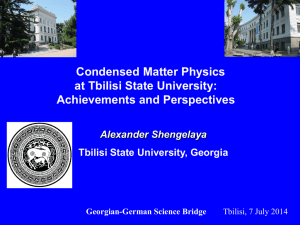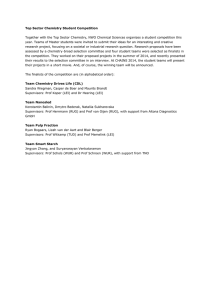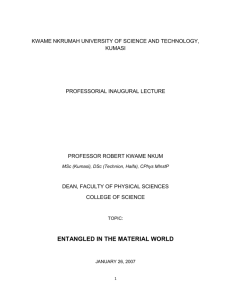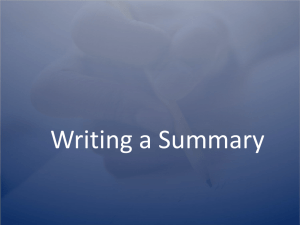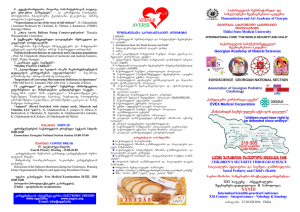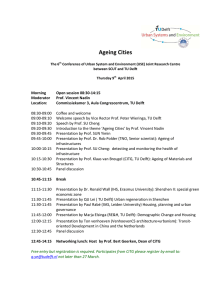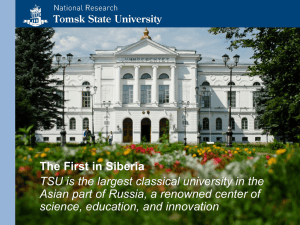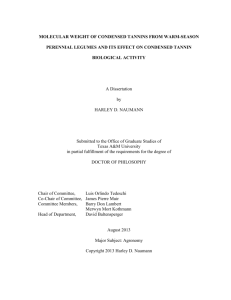Condensed Matter Physics and Materials Science at TSU: Past
advertisement
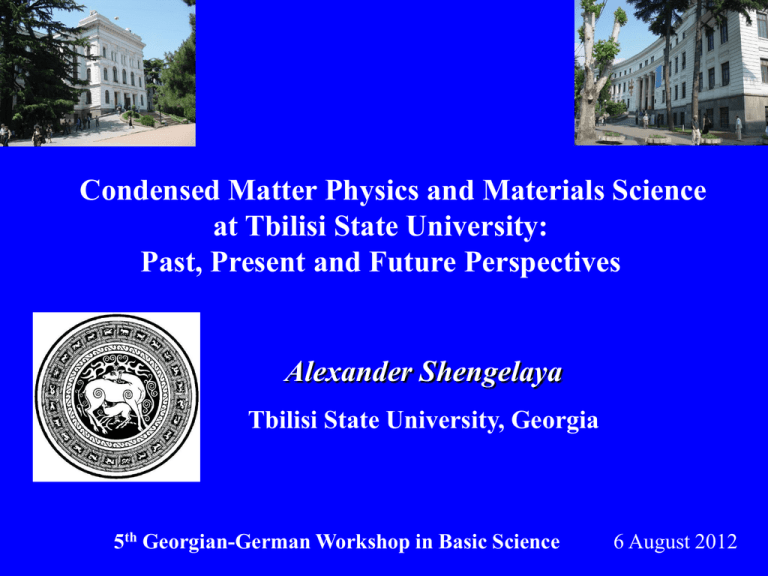
Condensed Matter Physics and Materials Science at Tbilisi State University: Past, Present and Future Perspectives Alexander Shengelaya Tbilisi State University, Georgia 5th Georgian-German Workshop in Basic Science 6 August 2012 What is Condensed Matter Physics ? Condensed matter physics is a branch of physics that deals with the physical properties of condensed phases of matter. The most familiar condensed phases are solids and liquids, while more exotic condensed phases include the superconducting phase, the ferromagnetic and antiferromagnetic phases. The diversity of systems and phenomena available for study makes condensed matter physics the most active field of contemporary physics: one third of all American physicists identify themselves as condensed matter physicists, and The Division of Condensed Matter Physics is the largest division of the American Physical Society. The field overlaps with chemistry, materials science, and nanotechnology, and relates closely to atomic physics and biophysics. Theoretical condensed matter physics shares important concepts and techniques with theoretical particle and nuclear physics. Why it is important ? • Understanding the electrical and magnetic properties of solids and liquids is right at the heart of modern society and technology. • For example: The entire computer and electronics industry relies on tuning of a special class of material, the semiconductor. • New technology for the future will inevitably involve developing and understanding new classes of materials. Discovery of Transistor First chip in 1961 1000 Transistors Pentium 4 processor in 2002 100 000 000 Transistors Pauli about semiconductors In 1931 Wolfgang Pauli famously wrote to the Physicist, Rudolf Peierls “Ueber Halbleiter sollte man nicht arbeiten, das ist eine Schweinerei, wer weiss, ob es überhaupt Halbleiter gibt.” “One shouldn’t work on semiconductors, that is a filthy mess; who knows if they really exist!” Prof. Elevter Andronikashvili Elevter Andronikashvili started the experimental condensed matter physics research at Tbilisi State University in 1948. In 1950 he founded Institute of Physics of Georgian Academy of Science. In 2011 AIP merged Javakhishvili Tbilisi State University E. Andronikashvili is internationally recognized by the physics community after his outstanding experimental investigations of the superfluidity of liquid helium. Prof. Givi Khutsishvili Pioneering work on theory of diffusion and relaxation of nuclear spins in crystals. He introduced a new phenomenon called “spin diffusion” in 1954, which is widely used now in magnetic resonance. This work is still significant and is quoted in monographs on the theory of magnetic resonance in its original form. Prof. Khutsishvili made an invaluable contribution to the education of scientists in Georgia. Several generations of Georgian physicists have attended his lectures and seminars at which they learned the theoretical foundations of modern physics. Niels Bohr with wife and son visiting TSU In 1961. Magnetic Resonance Imaging (MRI) System for medical applications. Superconductivity discovered by H. Kammerling-Onnes in 1911: a wide range of applications from the energy to the electronics sector. MRI includes: Superconductivity, Nuclear Magnetic Resonance, Low temperature Physics, Mathematics... Prof. Tengiz Sanadze Pioneering experiments in magnetic resonance by Prof. T. Sanadze in 1960. Building of the first pulsed Electron Paramagnetic Resonanse (EPR) spectrometer. Discovery of the new phenomena of discrete saturation This technique is now used in commercial EPR spectrometers produced by German company BRUKER. EPR spectrometer donated by Prof. K. A. Müller (IBM and University of Zürich) was installed at TSU in 2006 Cryogen Free / Liquid Helium Measurement System was installed in our laboratory October 2009 Temperature range 1.6 – 300 K Superconducting magnet up to 5 Tesla Funded by Ministry of Education and Science and Tbilisi State University Cryogenic Center was created at TSU in 2010 Supported by Georgian National Science Foundation Liquid Nitrogen Plant Liquid Helium Plant Experiments at Large Scale Facilities Mainly at Paul Scherrer Institute (PSI) Switzerland: Muon-spin rotation (µSR) Nautron Scattering (SINQ) Sinchrotron at Swiss Light Source (SLS) Institute of Applied Semiconductor Technologies at TSU Director: Dr. Zaur Chakhnakia Prof. A. Bibilashvili Dr. N. Khuchua Dr. Z. Jibuti Dr. N. Dolidze Main Research directions: 1. New type of concentrators for solar cells. 2. GaAs epitaxial thin film structures for THz radiation sources. 3. Development and production of microelectromechanical (MEMS) systems. 4. Study of photostimulated diffusion processes in semiconductors. Institute of Applied Semiconductor Technologies at TSU CAD-RoomCAD-Room with local (supported NATO SfP Project) withnetwork local network (supported by by NATO SfP Project) Contact litography Contact litography Metal evaporation Metal evaporation Control of technological parameters Control of technological parameters Dry etching Dry etching Wage bonding Microwave characterization lab Condensed Matter Theory at TSU Prof. Archil Ugulava 1. Nonlinear phenomena and Quantum chaos. 2. Stochastic processes. 3. Magnetic clusters. Assistant Prof. Tamar Chelidze 1. Investigation of luminescence spectra of CdSe Nanowires (in collaboration with University Norte Dame, USA). 2. Investigation of many body effects in semiconductor quantum structures. Excitonic effects is studied in quantum structures of different type. 3. Investigation of Variable range hopping conduction in magnetically disordered FeTiO3 epitaxial thin films (in collaboration with Versailles University, France). Institute of Condensed Matter Physics and Advanced Materials Director of Institute: Prof. A. Shengelaya Was created at TSU in 2009 to consolidate research and teaching activities in this field. Includes condensed matter scientists working in Georgia as well as abroad. Main topics of research: • Macroscopic and microscopic properties of novel superconducting and magnetic materials. • Magnetic nanoparticles and their applications. • New methods of synthesis of advanced materials. Broad international collaborations: University of Zürich, Switzerland ETH Zürich, Switzerland Paul Scherrer Institute, Switzerland Max Planck Institute for Solid State Research, Stuttgart, Germany Jülich Research Center, Germany University of Versailles, France What has been achieved ? New Bachelor and Masters programs Selective module in Physics Bachelor program “Applied Physics”, which includes: Materials science, Physics on nanoscale, Micro- and nanoelectronics. Masters program in “Applied Physics”, which includes selective module in Materials science, Micro- and nanoelectronics. Masters program in “Fundamental physics”, which includes selective module in Condensed Matter Physics. Graduate Students: Alexander Maisuradze (PostDoc at the University of Zürich/PSI) Zurab Guguchia (PhD at the University of Zürich) Zurab Shermadini (PhD at PSI) Mamuka Chikovani (PhD at PSI) Giorgi Gambashidze (Candidate for PhD at MPI Stuttgart) Giorgi Khazaradze (Candidate for PhD in collaboration with Jülich) What has been achieved ? Upgraded experimental infrastructure (as shown in previous slides). At present 4 projects are running at the Institute of Condensed Matter Physics: 1 Project funded by Shota Rustaveli National Science Foundation. 2 Projects funded by Swiss National Science Foundation. 1 Project funded by Science and Technology Center in Ukraine. Research Highlights (selected to be an Editor’s suggestion) Research Highlights (selected to be an Editor’s suggestion) Research Highlights (selected to be an Editor’s suggestion) ivane javaxiSvilis saxelobis Tbilisis saxelmwifo universiteti Ivane Javakhishvili Tbilisi State University International conference celebrating the 80’th birthday of K. A. Müller and the 20’th anniversary of the Nobel prize for the discovery of high temperature superconductors by J. G. Bednorz and K. A. Müller HTSC – 2007 High-Temperature Superconductivity in Cuprates Original Concept and New Developments October 7-11, Tbilisi, Georgia 26 HHigh Temperature Superconductivity ••• 28 Future perspectives Prof. Alex Müller visiting our lab in November 2011 Start of the New Project !
